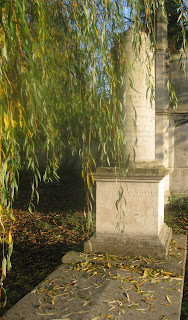On a rather chilly Sunday morning in November the OH and I went for a wander to West Norwood Cemetery armed with the camera
and my copy of Meller and Parsons' 'London
Cemeteries; An Illustrated Guide & Gazetteer' 4th Edition, 2008 which I
got for Christmas a couple of years ago from said OH!
It’s one of the original “Big Seven”
cemeteries that were created following authorisation by the government in 1832.
West Norwood was opened in 1837 and
is the final resting place for quite a few famous faces. More information about
West Norwood can be found on the ‘Friends of West Norwood Cemetery here.
There are numerous famous faces buried
in this cemetery, and yes I admit I did have to look most of them up!
First up I'm going to share with
you my photograph of the monument of Rev.
James Balwin Brown (1820-1884). Rev. Brown was one of the first the
graduate from the University of London and he preached at the Brixton
Independent Chapel
Next up is the grave of William Wyon (1795-1851). William Wyon
was the chief engraver at the Royal Mint and he designed the profile of Queen
Victoria for the Penny Black.
His stone was off the main track of
the cemetery, and was hidden under a pile of leaves. What I especially liked
about this stone is that the family servant, Martha Butler, was also remembered on the stone…at the bottom of
course!
This rather unremarkable stone
filled with names belongs to one George
Jennings (1801-1882), who invented the public toilet!
This memorial belongs to William Marsden (1796-1867), the English
surgeon who founded the Royal Free Hospital and the Royal Marsden Hospital in
London.
One of the more interesting
monuments is that of John Wimble
(1797-1854) who died at sea. Janet Weeks published a detailed account of
John Wimble in the Friends of West Norwood Cemetery newsletter entitled ‘John Wimble (1979-1851) ~ A Life at Sea’
(Issue 69; September 2010:6-9) and a pdf
of the newsletter is available here.
This magnificent moment belongs to a banker named James Gilbart (1794-1863). He was also
an author and wrote a book called Practical
Treatise on Banking in 1827; this book was very well received and was used
to improve the British Banking System, as well as leading the way for the
Building Society movement. It’s a shame
he’s not around to improve the modern banking system!
From the non-famous residents of the
cemetery I especially liked the following monuments and stones;
This, for me, is an interesting example
of the detail that could be included on my epitaph, although it is rather sad I
would love to find such details on a stone of my own ancestors.
Ellen
Elizabeth Jell the beloved wife of Harry T Jell
Who
passed away suddenly after a painful operation
On
the 19th of April 1904. Aged 30 years.
Beloved
and deeply mourned by all who knew her
Born
Easter Sunday April 3rd 1874
On that happy Easter morning
All the graves their dead restore
Father sister child and mother
Meet once more
On this rather weathered old stone you
can still make out the lion that is guarding the moment for eternity.
I also photographed 30 Commonwealth War
Graves within the cemetery which I shall be uploading to Find A Grave in due course. My original
intention was to upload them to The War
Graves Photographic Project, however as the pictures may not meet their
specifications I have decided to put them on Find A Grave instead.
All photos on this blog were taken by me
during our trip to the cemetery in November 2011.











